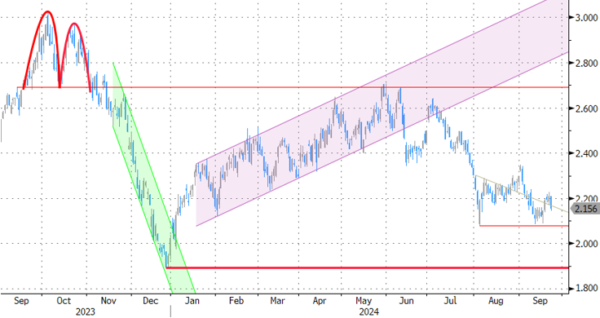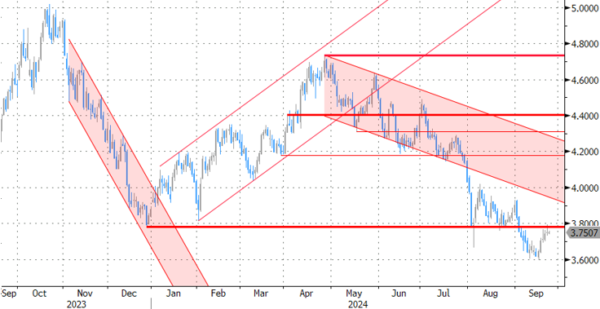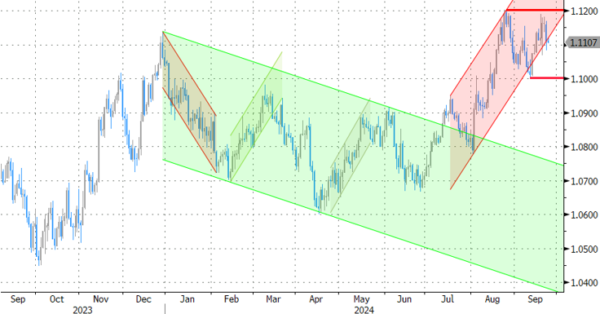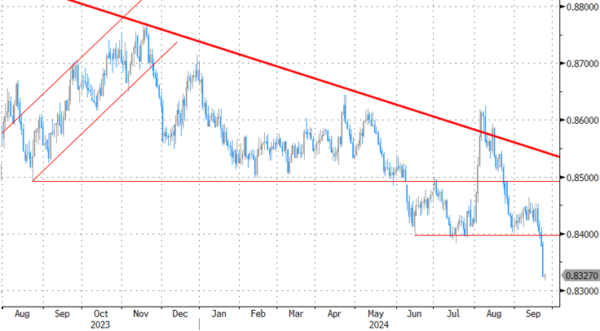Markets
Horrible European PMI business confidence (September) triggered a textbook bull steepening. German rates dropped between -2.8 (30-yr) and -8.1 (2-yr) bps. The spread between the 10-yr and 2-yr hit a milestone by turning positive for the first time since November 2022. Swaps did so already last Friday. Front-end outperformance rooted from increased ECB easing bets. An October cut – which president Lagarde and other policymakers all but ruled out – is about 40% discounted. US rates eked out less than 1 bp across the curve. They were on track for larger gains (up to 6 bps intraday) but another escalation in the Middle East conflict caused some safe haven flows in late European afternoon trading. The topic increasingly grabs (media) attention and bears following up. Several Fed governors including Atlanta’s Bostic, Minneapolis’ Kashkari and Chicago’s Goolsbee signaled openness (though did not commit) to back-to-back 50 bps moves if warranted by the data. Their comments perhaps readied US Treasuries for lift-off, all they needed was a trigger. The euro greatly underperformed G10 currency peers. EUR/USD temporarily dropped sub 1.11 before closing at 1.1111, down from 1.1159. The common currency’s slid all day long against sterling. EUR/GBP tanked from 0.838 to 0.832, dropping below the previous YtD low and interim support at 0.834 (August 2022 interim low). UK PMI’s (52.9 composite), even though easing from the August readings, contrasted starkly with the European ones as they suggested still-decent growth. Today’s advanced economy calendar is pretty meagre with only US consumer confidence (Conference Board) scheduled for release. Fed Bowman’s speech on the monetary and economic outlook is worth watching since she dissented last week by voting for a 25 bps cut. Turning to markets, we are on the lookout whether yesterday’s sharp European yield drop may ease. The German 2-yr yield is near an important support zone just north of 2% (March 2023 low). Longer maturities trade a bit more comfortable above the first support levels. US short-term yields continue to consolidate while the long-end forces out a bottoming out. EUR/USD’s decline yesterday had no technical implications but the move in EUR/GBP, if confirmed in coming days, paves the way for a return to the 2022 low (0.8203).
News & Views
The Central bank of China this morning announced a broad set of measures to support economic growth and help to address the crisis in the property market. The package comes after a series of disappointing eco data indicating that this year’s growth target of about 5% is at risk. The measures also aim to boost consumer confidence. The PBOC will reduce the reserve requirement ratio (RRR) by 0.5%pts, freeing 1 trillion yuan of liquidity. Depending on the liquidity situation, the RRR might be further reduced by 0.25-0.50 ppts later its year. It will lower the 7-day reverse repo rate by 0.2%pts to 1.5%. The interest rate on the medium term lending facility will be reduced by about 30 bps. Measures to support the property market include an on average 50 bps reduction on the interest rate of existing mortgages and a reduction of the minimum downpayment requirement to 15%. The PBOC announced tools to support capital markets by providing easier access to funds, brokers, insurers and commercial banks to directly or indirectly support buying of equities. The CSI 300 index adds 3.4%. China’s 10-yr yield initially declined a few bps but currently trades near 2.06% again. The yuan gains from opening levels near USD/CNY 7.06 to 7.035.
The Reserve bank of Australia today as expected kept its policy rate unchanged at 4.35%. The RBA maintains a rather hawkish stance. Inflation as fallen substantially from the 2022 peak, but with underlying inflation still at 3.9% in June, it is still some way above the 2-3% target. Even as headline inflation may fall further temporarily, it is not expected to sustainably return to target until 2026. Growth was weak in Q2, but labour market conditions remain tight, despite some signs of gradual easing. Sustainably returning inflation to target within a reasonable timeframe remains the Board’s highest priority. Recent data have reinforced the need to remain vigilant to upside risks to inflation and the Board is not ruling anything in or out. Policy will need to be sufficiently restrictive until the Board is confident that inflation is moving sustainably towards the target range. Despite the hawkish stance the 3-y Australian government bond yields eases slightly to 3.5%. Markets still see about 50% change of a first rate cut in December. The AUD/USD cross rate is nearing the December 2023 top (0.687).
Graphs
GE 10y yield
The ECB cut policy rates by 25 bps in June and in September. Stubborn inflation (core, services) make follow-up moves less evident. We expect the central bank to stick with the quarterly reduction pace. Disappointing US and unconvincing-to-outright-weak EMU activity data dragged the long end of the curve down. The move accelerated during the early August market meltdown.
US 10y yield
The Fed kicked off its easing cycle with a 50 bps move. It is headed towards a neutral stance now that inflation and employment risks are in balance. Conservative SEP unemployment forecasts risk being caught up by reality and with it the dot plot (50 bps more cuts in 2024). We hold our call for two more 50 bps cuts this year. Pressure on the front of the curve and weakening eco data keeps the long end in the defensive for now as well.
EUR/USD
EUR/USD moved above the 1.09 resistance area as the dollar lost interest rate support at stealth pace. US recession risks and bets on fast and large rate cuts trumped traditional safe haven flows into USD. EUR/USD’s recent dollar-driven ascent stumbled into resistance around 1.12. The ailing euro(pean economy) is offsetting some of the general dollar weakness.
EUR/GBP
The BoE delivered a hawkish cut in August. Policy restrictiveness will be further unwound gradually on a pace determined by a broad range of data. The strategy similar to the ECB’s balances out EUR/GBP in a monetary perspective. But the economic picture is increasingly diverging to the benefit of sterling. EUR/GBP succumbed to horrible European September PMI’s. Support at 0.84 broke and brings the 2022 low (0.8203) on the radar.
















